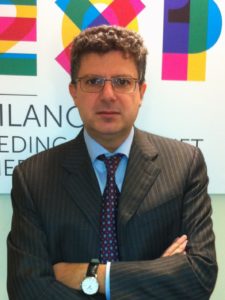
Photo: dreamstime_s_211252903
What is the city’s role in connectivity?
12 September 2023
by Jonathan Andrews
Cities Today asked four city leaders from Europe and North America about their approach to connectivity.
What significant advancements have been made in addressing connectivity challenges in your city?
Martin Vavrek, Director of Digitalisation, City of Bratislava: Bratislava has made substantial progress in establishing a robust 100-kilometre fibre network. Our primary objective has been the development of a digital counterpart to this physical network.

Guido Arnone, CTO, Municipality of Milan: Milan has become the first city in Italy with 5G coverage. This has historically been a top priority in regards to connectivity for the city. Right now, we are in the final booster stage of installing 5G coverage, as we have already reached 90 percent outdoor coverage of the city.
Frank Vieveen, Programme Manager, Urban Digital Innovation, Rotterdam City Council: After reaching agreements with telecom companies to deploy fibre, we involved all colleagues across the council to ensure the rollout took place with as little inconvenience as possible for residents. Once the auction of 5G frequencies have taken place in the Netherlands, we aim to see 5G rolled out across Rotterdam.
Alice Xu, Director, Digital City, Technology Services, City of Toronto: Bringing public Wi-Fi to key geographic areas, implementing a municipal policy framework to ensure ethical deployment of technologies, and partnering with cities in our region and across Canada to learn and advance shared goals.
How do you perceive the city’s role in the connectivity space, and how has this evolved over time?
Martin Vavrek, Bratislava: Our primary emphasis lies on internal connectivity, which includes city-owned buildings, traffic management, security systems, traffic monitoring via cameras, and a sensor network for the Internet of Things (IoT). However, we are undergoing a transformative phase in terms of how we leverage our city’s connectivity assets.

Guido Arnone, Milan: We are not the owner of the service, which is operated by the fixed line and mobile operators. But what we can do is create the conditions to facilitate the telecommunication infrastructure. We can leverage this enabler aspect for our own services, not only connectivity services, but also IoT, monitoring and sensors – all the value-added services that you can build on this infrastructure.
Frank Vieveen, Rotterdam: Our role is mainly to facilitate a successful roll-out, but to also ensure it fits into the subsurface. This role has become more important in recent times because more urban objectives or challenges require a place in the subsurface, such as the municipal heating network, charging points for electric cars, and solutions for climate adaptation.
Alice Xu, Toronto: IT divisions used to be focused entirely on internal services for the municipal government. While this remains the bulk of our division’s effort, this has shifted in two ways. Firstly, we now work on bringing connectivity to the public and bridging the digital divide, and secondly, we think extensively about the resident’s experience and expectations in using the government service technologies that we are implementing. The public is much more present in the work we are doing today.
What are the main obstacles you still encounter in bridging connectivity disparities?
Martin Vavrek, Bratislava: Conflicting municipal priorities, bureaucratic permit procedures, adherence to public procurement regulations, and constraints related to our budget allocation.

Guido Arnone, Milan: We have an open Wi-Fi network that although not very big, covers the main hot spots of the city. As a municipality we are interested to explore new business models where operators could take advantage of this network and, eventually, operate it by itself and explore ways in which the cost is covered by other services.
Frank Vieveen, Rotterdam: Our main challenge is the orderly management of the outdoor space and subsoil with a thorough balance between the diverse interests of the various relevant parties. This requires specific knowledge but also another way of prioritising in an ever-changing field of participants, including our citizens.
Alice Xu, Toronto: We know that the digital divide persists in Toronto, not only because we hear it from the public but also because we regularly undertake key research in partnership with local higher educational institutions to document it. This indicates that the telecommunications services cost burden continues to be the most serious connectivity problem for residents and Canadians generally, with access to devices being a related challenge.
Do you believe that collaboration between municipalities and telecommunications companies could be improved, and if so, how?
Martin Vavrek, Bratislava: Historically, the city has faced limitations in coordinating connectivity-related activities with telecommunications firms, largely due to a lack of specialised skills, expertise, and a dedicated focus. We anticipate that our ongoing city lighting reconstruction project will usher in a new era of collaboration, fostering improved coordination between telecommunications firms and the municipal administration.
Guido Arnone, Milan: Sharing data and sharing as much as possible. In Milan, the infrastructure is already well established but we would like operators to help us better leverage this infrastructure. 5G expectations were very high but right now we haven’t yet seen disruptive products or services. As a municipality, I would like to see 5G improve the portfolio of our services, and to add value to these services through the benefits that 5G can provide.

Frank Vieveen, Rotterdam: In Europe, certainly, because most European cities are subject to the same telecom legislation. Learning from each other is key and there are also issues for which we can lobby jointly.
Alice Xu, Toronto: During the pandemic, we partnered with telecommunications firms to deliver Wi-Fi connectivity at no cost to key apartment towers that did not have adequate access. This is an example of the opportunity that we see: the resources and reach these firms have to address public need can be matched with the municipality’s knowledge base and commitment to ensuring that technologies are deployed in ethical and efficient ways.
This article is part of a series to mark the launch of the City Telecoms Association, a new global public-private network to help shape the future of urban connectivity. Find out more about membership and upcoming events. The next meeting takes place in London on October 3-4, 2023.











